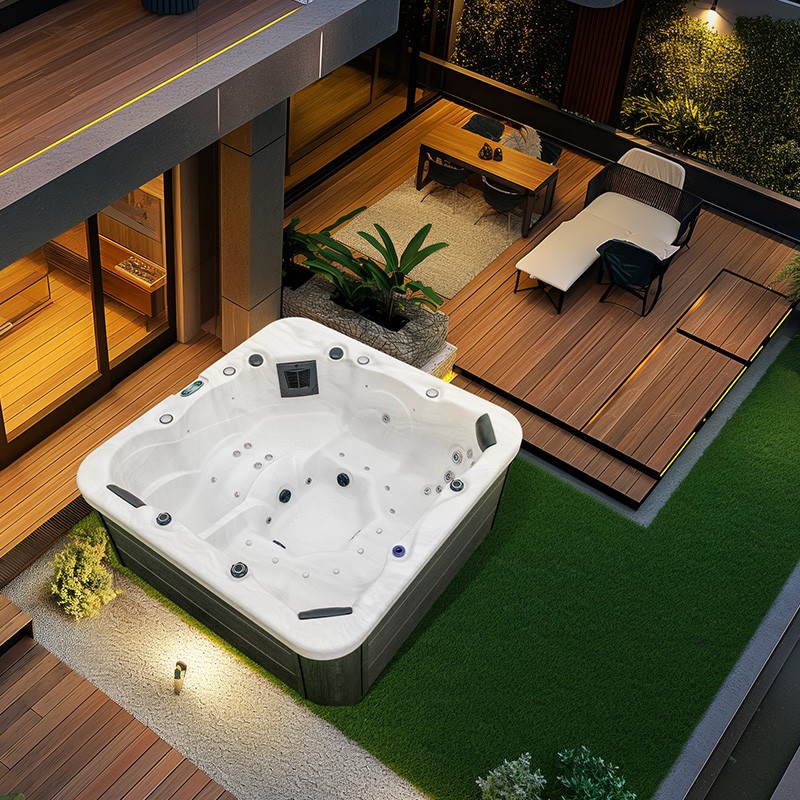
What are some common mistakes made when moving spa jacuzzi tubs?
2025-11-27 15:35A freestanding spa jacuzzi bathtub is a large bathroom fixture that integrates spa, massage, and relaxation functions. It is large, heavy, and complex in structure. Whether for home relocation, commercial installation, or dealer delivery, the moving process is crucial. Slight carelessness can lead to equipment damage, malfunction, or even personal injury.
Many people underestimate the complexity of a freestanding jacuzzi bathtub when moving it. This article will analyze common mistakes made during moving to help you understand how to move a freestanding jacuzzi bathtub scientifically and safely, avoiding unnecessary losses.
Why is the moving process of a freestanding spa jacuzzi bathtub so critical?
It is not just a "large bathroom product," but a precision device containing an electrical system, water circulation system, nozzles, piping, and outer supporting structure.
A standard two- or three-person freestanding spa jacuzzi bathtub can weigh between 200 and 400 kilograms and contains components such as a motor, heater, and filtration system. Any improper movement, tilting, or impact can cause:
• Damage to the water pump and motor;
• Piping system breakage or leakage;
• Cracks in the casing or base;
• Loose electrical wiring;
• Even affecting subsequent normal operation.
Therefore, proper handling not only affects the lifespan of the equipment but also directly relates to user safety and subsequent maintenance costs.
Why can't you rely solely on manpower to move a freestanding jacuzzi bathtub?
Many users believe that having enough manpower is enough to move a freestanding spa jacuzzi bathtub. In fact, this is one of the most common and dangerous mistakes.
There are three reasons:
1). Uneven weight distribution
The center of gravity of a freestanding spa jacuzzi bathtub is not in the center but rather biased towards the bottom or one side. Lifting it manually can easily cause one side to tilt or sag, damaging the base.
2). Large size and high center of gravity
Large bathtubs are typically over 2 meters in length, making it difficult to find suitable grip points during transport. Forcibly moving the bathtub can easily result in collisions with door frames, walls, floors, or corners.
3). Lack of Professional Tools
Lifting the bathtub by hand without using equipment such as carrying belts, rollers, hoisting slings, or mobile carts increases the risk of falls and may cause back or arm injuries to the movers.
The correct approach is to use professional moving equipment and plan the route in advance, ensuring that the path width, door frame dimensions, and power supply locations are all confirmed correctly.
Why should the freestanding spa jacuzzi bathtub be completely drained before moving?
Many people forget to drain the water and residual liquid from the tub and pipes before moving, which is an extremely common mistake.
The risks of not draining include:
• Residual water in the pipes may flow back during moving, causing electrical components to become damp;
• Excess weight increases the difficulty of moving, easily leading to imbalance or falls;
• A damp environment may cause short circuits or corrosion in the electrical control system;
• Residual water may splash out during transportation, contaminating the vehicle or ground.
The correct operating procedure should include:
• Disconnect the power supply;
• Open the drain valve to completely drain the water;
• Wipe the inside clean with a dry cloth;
• Keep the pipes dry.
Draining not only reduces weight but also effectively protects the motor and heating system from damage.
Why remove accessories before moving a Freestanding Spa Jacuzzi Bathtub?
Another often overlooked step is the disassembly and securing of accessories. Many people choose to move the entire unit to save time, resulting in the nozzles, control panels, covers, and other components becoming loose or broken.
Freestanding Jacuzzi Bathtubs typically come with the following external or moving parts:
• Control panel;
• Shower head cover;
• Filter cartridge and suction inlet;
• Armrests and headrest;
• Inlet and outlet hoses;
• External decorative panels.
Before handling, you should:
• Remove movable parts and pack them separately;
• Protect electrical components with shock-absorbing foam or bubble wrap;
• Seal interfaces and cable ports to prevent dust and moisture from entering;
• Cover with a dust cover to protect the acrylic surface.
These details not only prevent cosmetic damage but also prevent internal parts from loosening due to transport vibrations.
Why can't you move the freestanding jacuzzi bathtub horizontally or vertically?
The internal structure of the freestanding spa jacuzzi bathtub dictates its posture. Many people attempt to move the bathtub vertically to "save space" or "make it easier to pass through doorways," but this is extremely dangerous.
The reasons are as follows:
• Fixed position of the motor and heater: Vertical handling will subject them to gravitational pressure, causing displacement or loosening;
• Connections in the piping system: Excessive tilting can easily pull on the pipes, causing the joints to loosen;
• Uneven stress on the acrylic shell: The bathtub shell is designed for horizontal stress, and standing it upright can cause structural deformation or even cracking;
• Unstable center of gravity, prone to tipping: Especially on stairs or ramps, this poses a greater risk of danger.
The correct approach is:
Always keep it horizontal during transport, ensuring even stress on all four corners, and use reinforcing boards or straps if necessary.
Why does ignoring ground and passageway conditions lead to transport failure?
Many people do not assess environmental conditions before transport, resulting in the bathtub getting stuck in doorways, scratching walls, or damaging it.
Common mistakes include:
• Forgetting to measure the width of door frames and corners;
• Uneven, slippery, or obstructed ground;
• Narrow transport path, limiting the carrying angle;
• Lack of anti-slip mats or support boards on stairs and steps.
Freestanding jacuzzi bathtubs are typically large, and forcing them through narrow passages can easily scratch or dent the acrylic surface, and even damage the support frame.
Before moving, it is recommended to:
• Measure all passage dimensions in advance;
• Clean the floor, ensuring it is dry and level;
• Prepare a sturdy ramp or temporary support structure if moving the tub up or down stairs;
• Protectively wrap the walls at corners.
Why neglecting packaging and protection is a fatal mistake?
Freestanding spa jacuzzi bathtubs are mostly made of high-gloss acrylic or fiberglass composite materials, which are extremely prone to scratches or deformation under pressure. Many people simply wrap them with a thin film during transport, which does not provide adequate protection.
Common mistakes include:
• Moving the unwrapped bathtub directly;
• Only wrapping the top or parts of the tub;
• Using non-waterproof materials;
• Neglecting corner and edge protection.
Proper protective measures should include:
• Fully wrapping the bathtub with thick foam, pearl cotton, or shock-absorbing bubble wrap;
• Reinforcing the four corners;
• Using a waterproof film for the outer layer;
• Securely fastening the bathtub to the vehicle with straps to prevent slippage.
Good packaging not only prevents scratches but also protects against vibrations and impacts during handling.
Why are electrical components often overlooked during handling?
The electrical system of a freestanding spa jacuzzi bathtub is one of the most vulnerable parts, yet it is often neglected during handling. Even if it appears intact, internal wiring may become loose due to vibration, potentially causing malfunctions after installation.
Common problems include:
• Loose or broken wire connections;
• Poor heater contact;
• Moisture on the control panel;
• Detached grounding wire.
The correct procedures are:
• Disconnect all power connections before handling;
• Seal electrical interfaces;
• Waterproof and shockproof treatment for the electrical control box;
• Recheck connections for security after handling.
Neglecting electrical safety issues can lead to more than just repair costs; it can also pose a risk of electric shock.
Why does a lack of advance planning for the installation location affect moving it?
Many people only discover insufficient installation space, incorrect drain pipe placement, or incompatible power supply when moving their freestanding spa jacuzzi bathtubs, resulting in rework or repeated moves. This not only wastes time but also increases the risk of damage.
Planning the installation location in advance should consider at least the following factors:
• Space dimensions (ensuring the bathtub can fit comfortably);
• Floor load-bearing capacity (standard requirement ≥350kg/m²);
• Drainage system location and slope;
• Power outlet and control panel location;
• Ventilation and moisture protection conditions.
Completing on-site measurements and layout planning before moving can significantly reduce the likelihood of repeated moves.
How to properly move a freestanding jacuzzi bathtub to avoid mistakes?
The best way to avoid mistakes is to follow a systematic handling process:
Preparation Phase:
• Drain water;
• Remove moving parts;
• Check power and water pipe connections;
• Pack for protection.
Environmental Inspection:
• Clear passageways;
• Assess floor load-bearing capacity;
• Plan handling route.
Handling Execution:
• Use professional handling tools (rollers, slings, trolleys);
• Maintain horizontal movement;
• Avoid sudden tilting or collisions.
Transportation and Placement:
• Secure the bathtub in the transport vehicle;
• Load and unload slowly and smoothly;
• Conduct a thorough inspection after placement.
Following standard procedures significantly reduces handling risks and ensures the safety of equipment and personnel.
Safe Handling of the Freestanding Jacuzzi Bathtub Starts with the Details
The Freestanding Spa Jacuzzi Bathtub is a high-end bathroom fixture that combines comfort and technology. Handling it may seem simple, but every detail can determine the lifespan of the equipment and the user experience.
Common handling errors—such as failing to drain water, failing to disassemble parts, lack of protection, careless tilting, neglecting ground conditions, or improper electrical protection—can all have serious consequences. Only with thorough preparation, correct operation, and appropriate protection can the handling process be ensured safely and efficiently.
Remember: Handling is not a matter of brute force, but of skill.
Professionalism, care, and planning are the only ways to ensure your freestanding spa jacuzzi bathtub arrives at your new home intact.
What are the warranty terms when purchasing from LOVIA SPA?
Every LOVIA SPA product comes with a solid warranty plan covering 2–5 years, depending on the component. We provide 5 years for the structure, 3 years for the shell, and 2 years for components such as pumps, valves, and electrical parts.
This comprehensive coverage demonstrates our factory’s confidence in high-quality manufacturing. Buyers and suppliers working with LOVIA SPA enjoy after-sales service, spare part support, and long-term cooperation benefits.




